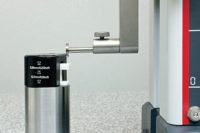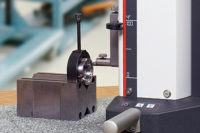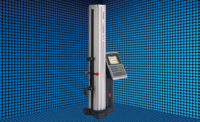Height gages measure the height of components and product features by measuring the distance from a reference point, usually a granite surface plate, to the component or product.

Height gages measure the height of components and product features by measuring the distance from a reference point, usually a granite surface plate, to the component or product. Height gages range from simple surface gages for measurement transfer and marking to motorized digital height gages. Height gages and their surface plates are versatile and relatively inexpensive, yet precise enough to be used as a rough incoming inspection tool or for final product approval.
"Low-end height gages can range from little more than a simple transfer stand with an indicator to a powerful data calculating tool with auto scanning functions," says Walt Wardzala, major instruments product manager at Mitutoyo America Corp. (Aurora, IL). "Digital displays help to eliminate errors as well as keep track of reference points. Higher end instruments feature accuracy down to almost 1 micron and perform tedious operator measurements with a keystroke."
Price and accuracy are key considerations when selecting height gages. "Pneumatic gliding systems require a granite plate for movement," adds Wardzala. "The benefit is greater ease of use and increased speed. Digital mechanical models are lightweight and durable. Accuracy and repeatability are more important than resolution. Make sure the model you select meets your tolerances. Mechanical digital, dial and electronic models are so affordable that few people bother with Vernier height gages."

Built-in preprogrammed functions make it easy to explore for diameters or maximum readings on parts. Source: Mahr Federal Inc.
Improved Accuracy
To examine the evolution of height gages, it helps to break down all the interrelated steps of the measuring process. The individual parts of the process include the standard-which is the reference scale built into the gage, the instrument-the design of the gage itself-the operator and the environment.Scales have come a long way. "Scales today are more accurate, can resolve to higher resolutions and use less power consumption," says George Schuetz, director of precision gages at Mahr Federal Inc. (Providence, RI). "So in effect, the standard, or master, in the gage is better, and in most cases, the improvement in scale performance has not affected price significantly.
"Height gages have undergone design changes to make them more accurate. Previously, in order to get stability and accuracy in a gage, it had to be big and heavy and made from lots of cast iron," Schuetz continues. "Today gages include lightweight materials that are designed for strength and stability. Electronics in the system can be programmed to compensate for errors in the assembly-length, squareness and straightness. These correction tables will significantly improve the performance of the system."

An operator measures a workpiece using a height gage equipped with test indicator and attachment. Any height gage that is not trigger-activated should have a test indicator to ensure accurate and repeatable measurements. Source: The L.S. Starrett Co.<
Operators, Temperature and Dirt
Operators can be a major contributor to gaging errors. Early and basic low-entry gages use manual drives to position the sensor to the part. By manually touching or tripping a sensing switch to trigger a measurement, the operator has a significant impact on the performance of the machine. How hard the part is touched and at what speed can significantly increase measurement variation."To train operators in the use of height gages, there has been a lot of emphasis in making their icons intuitive and easy to interpret for inexperienced operators," says Scott Robinson, tech support at The L.S. Starrett Co. (Athol, MA). "Icons such as ‘probing down' easily tell operators how to drive the gage and what to do with it, no matter what routine they are trying to execute."
More mid-range and high-end height gages are incorporating motor drives into their sensing heads. "This guarantees consistent measurement speed and touching force, which greatly improves repeatability and overall performance," says Schuetz. "Also, these height gages incorporate controllers that automate the simple measurement processes (length and diameter) so the measurement becomes a one-button operation-with virtually no operator involvement."
The environment is the main contributor to any length measurement, especially with a 40-inch height gage-a 1 F change over 40 inches is a 0.00024-inch deviation, so these errors can add up fast," Schuetz says. "Today, however, the controllers in the unit can compensate for these temperature changes, either by constantly monitoring the environment or correcting for the nominal temperature of the environment set by the operator."

Height gages can measure objects that may be too tall for a CMM to measure. Source: Mahr Federal Inc.

This is an automatic geometric calculating height gage with air suspension. Source: Mitutoyo America Corp.
Setting the references
Setting the references is an important part of the height gage measurement process. The first reference is when the machine sets its internal zero to the surface plate. The sensing head will come down, touch the plate and use this measurement as the reference for all future checks."It's not a bad idea to repeat the process, once or even twice, to be sure there is no dirt or some other condition to contribute to a bad reference setting," says Schuetz. "It's probably not a bad idea to also check to be sure the contact point is securely fastened. A loose contact point will introduce variability into the measurement and show up as a lack of repeatability."
The other reference that needs to be set is the diameter of the ball. If measurements are to be made approaching from the top and bottom, then ball diameter is critical. There is a test fixture and routine provided with height gages that check for ball diameter. Schuetz suggests following the routine at least twice to verify diameter and repeat.

This height gage has a special mechanical alignment feature that can be used in combination with a test indicator to accurately inspect the squareness of parts on a surface plate. Source: Brown & Sharpe TESA
Going Wireless
All electronic height gages transmit their information in the same basic way to computers and data-gathering devices. Information is digitized so readings can be used for statistical process control (SPC) and data collection. However, wireless communication also is available with height gages. "To go to wireless, all that is necessary is a transmitter device that can be attached to a port and a receiver at the computer," says Robinson. "And in the future, the radio also can be built into the gage. Before wireless, there was the problem with maneuverability around the surface plate. The cable can snag on the workpiece. With wireless data transmission, this problem is eliminated."But wireless transmission has traditionally had problems with signal interference and operator concerns. Radio signals can pick up other signals, resulting in this interference. "The latest wireless mesh networks eliminate this," adds Robinson. "With the newest technologies in ultra-low power radios and extremely robust network schemes now available, wireless electronic data collection is feasible and practical. Wireless data collection promises to eliminate transcription errors, illegible handwriting, keyboard mistakes, misplaced decimals, missing data and altered data."
In addition to wireless innovations, future height gages will benefit from full-feature displays with colors, pictures and instructions to help make the complex measurements easier for operators' use. "As with the motorized height gage, in the future we are likely to see features built into new height gage models which make them easier to use and capable of providing a higher degree of repeatability," says Lee Kirtlink, product manager at Brown & Sharpe TESA, (North Kingstown, RI).
Quality Tech Tips
For mor information on the companies mentioned in this articles visit their websites:
- Price and required accuracy are key considerations when selecting height gages.
- More mid-range and high-end height gages are incorporating motor drives into their sensing heads.
- Setting the references is an important part of the height gage measurement process





